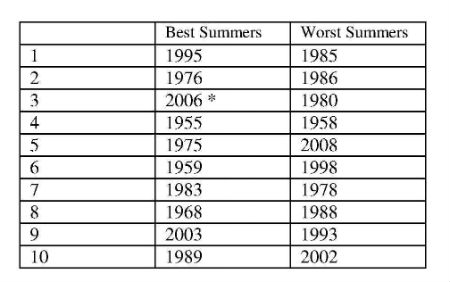|
Today we are experiencing a heat wave, its official. The weather forecaster on RTE obligingly defined a heat wave for the viewers just a few nights ago.
Definition: Five consecutive days (or more) with temperatures of five degrees above normal for the time of year. In effect, during the month of July that corresponds to a maximum daily temp of 25°C.
The normal maximum July temperature in the Dublin area would be around 19°C.
Last Friday, 12th July, the temperature at Casement Aerodrome, Baldonnell reached a max of 28.5°C, and an experienced weather observer confirmed that the temperature was exactly the same in Lucan.
The table below was compiled using the Poulter Index which is used widely by meteorologists and is a method of rating summer weather using a formula based on mean temperature, rainfall and sunshine for each weather station, i.e., the higher the index the better the summer weather.
Let’s see if this list of the 10 best and the 10 worst summers over the past sixty years jogs any memories.
60 Year Look Back

* On 19th July 2006 the temperature at Casement Aerodrome Baldonnell reached a high of 31°C, thereby breaking its own record for the station.
Some Weather Lore
On 15th July St Swithin’s Day the weather was warm (19°C) and dry throughout the country. Remarkably summer weather in Ireland is a little deficient in weather lore, St. Swithin’s Day being a notable exception.
Scairbhín Na gCuac (The Cuckoos Wind) occurs at the end of April and reminds us of the possibility of winter returning. Punchestown Racing Festival takes place around this time so we can all remember some mixed weather for the racing.
Feast of St. Luke St. Luke’s Day occurs on the 18th October and the weather on that day reminds us of the possibility of fine sunny weather even that late in the year.
Thank you to Denis Torsney for his expert research for this article.
|